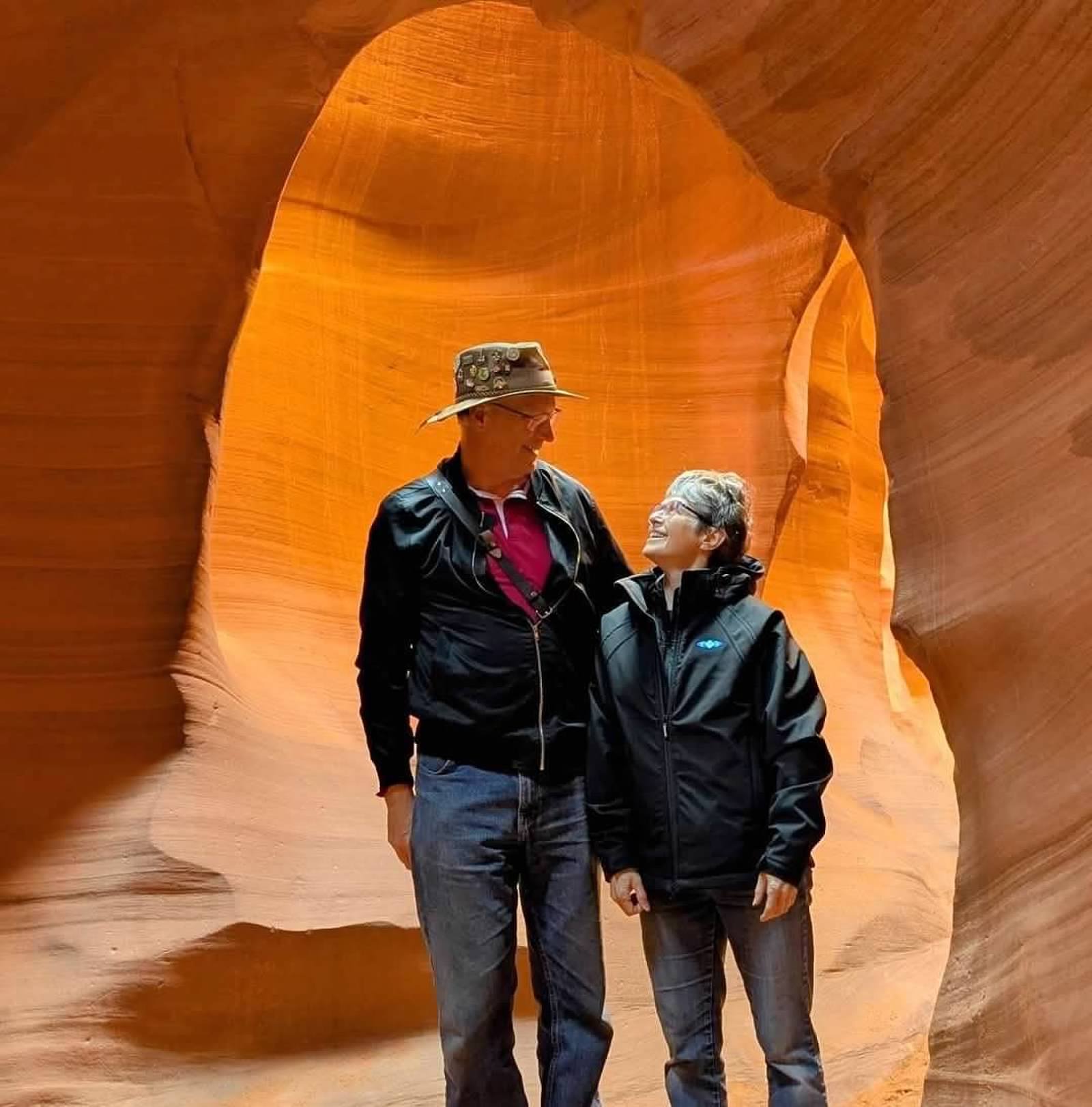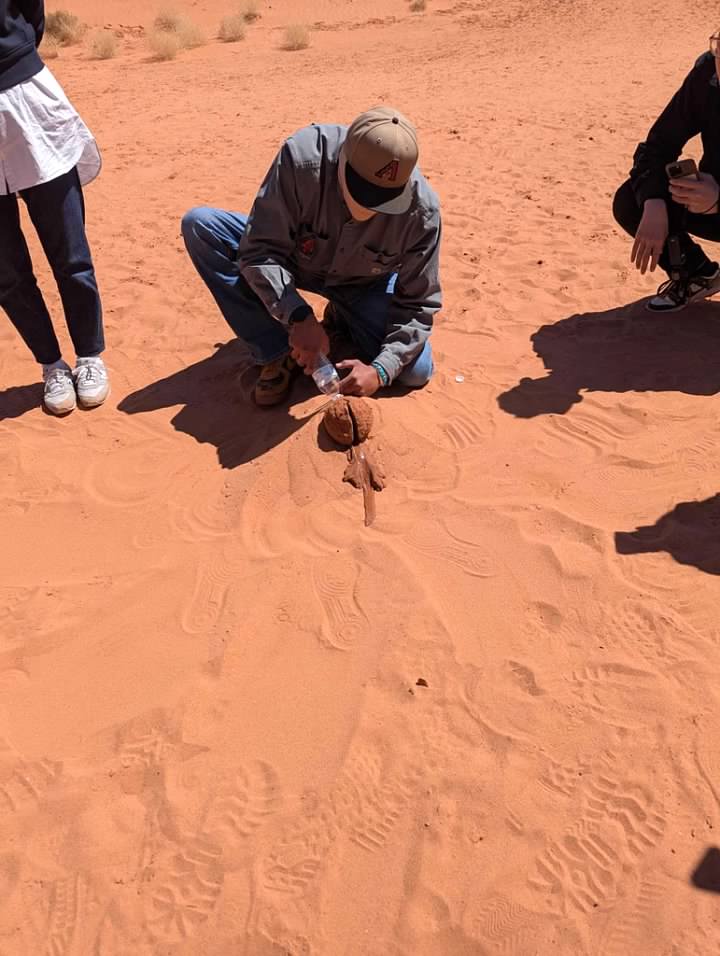I first became aware of Antelope Canyon when Microsoft used
a series of photographs from the canyon for one of the built in screensavers in Windows 7. Later, when we first visited Sedona, Arizona, we noticed that many of the tour companies there offered day trips up to visit Antelope Canyon. We were intrigued by the images, which were absolutely stunning, but decided it wasn't worth giving up an entire day in Sedona to see. Antelope Canyon could wait for another day. So, when we started thinking about our drive out and back for the bike tour, I naturally thought this was a great opportunity to finally visit the canyon.
Beyond the photos, I really knew very little about Antelope Canyon until I began researching for this trip. I knew that it was inside the Navajo Nation, but the significance of that wasn't immediately clear. One of the first things I learned was that there are actually two different canyons: an Upper and a Lower Antelope Canyon. After 11 people died in a flash flood in 1997, the Navajo Nation no longer allows free access to the canyons. All visitors are now required to be accompanied by a licensed tour guide. And each canyon is serviced by a different set of tour companies, so that which canyon you visit depends on which company you book with.
After looking at the various companies that offer tours in the Antelope Canyons, and comparing the reviews for each, I finally settled on
Dixie's Lower Antelope Canyon Tours and
Tsé Bíghanílíní Tours (for the Upper Canyon). Based on what I had learned, I decided to book the Lower Antelope Canyon earlier in the morning, and follow with the Upper Antelope Canyon tour later, around mid-day. This should give us optimum lighting conditions in each canyon during our tours. The tours were close enough together that we still had time to do other things that day, but spaced apart enough that we didn't have to worry about missing the second because of the first.
The other complication with booking these tours was ensuring that I was clear about exactly what time the tour began. This might seem like a trivial thing, but it is surprisingly challenging. The State of Arizona does NOT observe Daylight Savings Time, remaining on Mountain Standard Time year round. On the other hand, the Navajo Nation (which extends across state lines into parts of four states) DOES observe Daylight Savings Time, so that it is an hour earlier than the rest of Arizona from early March until early November. Further complicating matters, the tour companies for the Antelope Canyon Tours all booked their tours using Standard Time, largely because of their close proximity to the city of Page, which is not in the Navajo Nation. So, while my phone might switch to MDT when I enter the Navajo Nation, my tour was booked in MST, and I needed to plan my arrival accordingly.
Ultimately, everything was properly booked, and we had no problems arriving in time for our scheduled tours. In fact, we were sufficiently early for our Lower Antelope Canyon tour that they added us to an earlier tour group. The Lower Canyon is surprisingly close to the road, and our tour was done entirely on foot. The tour started out walking down to the lower end of the canyon, and it was surprising how little evidence could be seen of the canyon, even though we were walking along side it, just a few dozen yards away from it. After descending a series of stairs to the entrance to the canyon, we began our return up the canyon. Lower Antelope Canyon is wider at the top and very narrow at the bottom, at times just wide enough to place a single foot on the sand at the bottom. We started at the deepest end of the canyon and walked uphill through the canyon. Along the way, our guide stopped regularly to talk about the geology of the canyon, to point out various formations, and to help take photos. It just happened that this was our wedding anniversary, and our guide captured a lovely photo of us at the point in the canyon called "bridal arch".

The views inside the canyon were every bit as spectacular as anticipated, and I ended up taking a LOT of photographs. I probably could have taken even more, but our tour had to keep moving because there was another tour group right behind us, and another behind that, etc. This has become an incredibly popular attraction, for obvious reasons, and the guides have to keep the groups moving so that everyone has a chance to see it. I can only imagine what it must be like during a peak tourist season when the tour groups are all filled to capacity. I have read complaints about how this congestion leads to an overall feeling of being rushed through the canyon. Luckily, it wasn't that crowded, and while we knew that other groups were following us, I never felt like we were being pushed through the canyon too quickly.
Eventually, we reached the upper end of the canyon and emerged back out on top of the sandstone shelf, not far from where we had started our tour. Because we had joined an earlier tour than what we had booked, we found ourselves with extra time on our hands, which allowed us to relax and enjoy a Navajo dance demonstration before we headed across the highway to check in for our second tour.
The name of the company we used for our tour of the Upper Antelope Canyon, Tsé Bíghanílíní, means "the place where water runs through rocks" in Navajo. This is the Navajo name for the Canyon, and a description that became easier to understand when we finally arrived at the Canyon. But first we had to wait. While we were early for our tour, we weren't early enough to have time to go elsewhere and do something else, so we simply waited at the check-in point until our tour was called to board the four wheel drive truck out to the Canyon. Unlike the Lower Antelope Canyon, the Upper Canyon is not conveniently located next to the highway. Instead, it is located about three miles up the wash, requiring an off-road vehicle to reach it. The tour time slots are coordinated so that the trucks from one company pass those from another as they travel to and from the Canyon, with those from a third sitting at the site when we arrived.
From our truck, we walked straight into the Canyon, which was visible as a crack in the sandstone cliff in front of us. As we approached, it was easy to see how water spilling out of that crack to lead to the Navajo name for this place. The Upper Antelope Canyon is wider at the bottom and narrower at the top, which made it easier to move around in, and created eye-catching beams of sunlight. These beams are the reason that the midday tours are more popular (and more expensive, too). Again, we were just one of a number of tour groups working through the canyon in succession, so we didn't have lots of time to dawdle. But we had enough time to take in the surreal shapes and colors of the sandstone. The tour guides had a similar routine, talking about the canyon, pointing out interesting formations, and helping us take photos.
While our walk through the canyon was uphill, we didn't climb nearly as far through this canyon, and emerged from the canyon to find that the canyon sliced through a wall of sandstone. This meant that we had to climb up a ramp to a walkway across that sandstone slab and back down a set of stairs to return to the trucks for our return back to the highway. But before we did so, our guide stopped and gathered us around for a demonstration of how the canyons were formed. Using just the sand and a bottle of water, he showed how rainfall binds the sand into sandstone, how wind erosion removes the sand that isn't highly bound together, and how running water cuts through the sandstone to carve the canyons. It only took him five or ten minutes, but it was a vivid and easy to appreciate summary of the local geology.

Finally, we walked back to our trucks and rode back down the wash to the parking lot and our car. While there are certainly similarities in the appearances in both canyons, they are also both unique, and we are very glad we visited both.